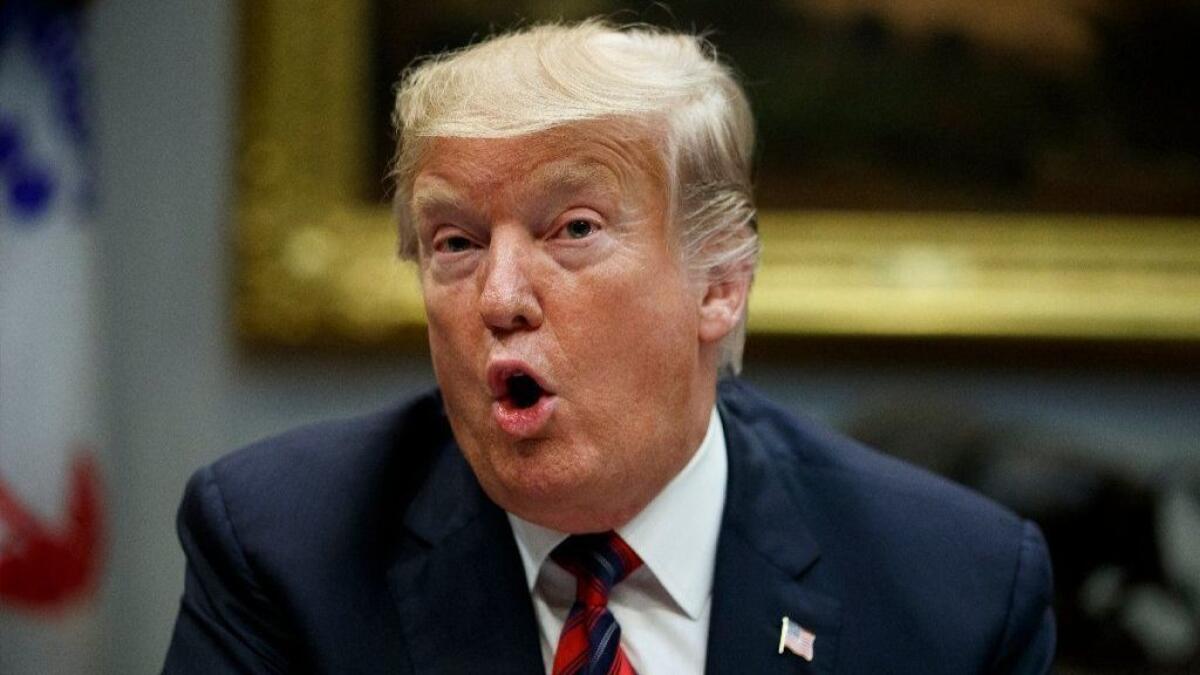Trump issues first veto, defying Congress’ rebuke of his border emergency order

- Share via
Reporting from Washington — With the first veto of his presidency, President Trump on Friday defied Congress’ bipartisan rejection of his declaration of a national emergency at the southern border and insisted on his power to circumvent the legislative branch to direct billions of dollars for a border wall.
Defiant despite a remarkable rebuke from Republicans as well as Democrats in Congress, Trump signed his veto before television cameras in the Oval Office, flanked by law enforcement officers and the parents of victims of crime and drug addiction.
While Congress likely can’t muster the votes to override his veto — the votes for the resolution in both houses were well short of the two-thirds that would be needed for an override — the emergency declaration still faces challenges in federal court as an executive power grab.
Critics have called his emergency declaration a violation of Congress’ constitutional powers, but Trump condemned the effort to block him, describing it as “dangerous” and “reckless.”
“Congress has the freedom to pass this resolution, and I have the duty to veto it,” he told reporters.
The president had quickly signaled his action moments after the Senate’s passage of the disapproval resolution Thursday when he tweeted “VETO!”
Moments after the actual veto, House Speaker Nancy Pelosi announced that the House would vote on an override on March 26. The San Francisco Democrat said in a statement that the president had “chosen to continue to defy the Constitution, the Congress and the will of the American people.”
Roughly 45 votes short of the 290 needed for an override, Pelosi sought to pressure House Republicans, saying they “will have to choose between their partisan hypocrisy and their sacred oath to support and defend the Constitution.”
If, as expected, the House fails to override the veto, the Senate would not act. If the House did succeed, its override measure all but certainly would not get the necessary 67 votes in the Senate.
On Thursday the Senate passed the resolution to terminate the emergency declaration by a vote of 59-41. Twelve Republican senators withstood pressure from the White House to join all 45 Democrats and two independents in voting for the resolution; there is virtually no prospect of additional Republicans switching sides now.
Thirteen Republicans supported the resolution in the House two weeks ago.
The number of Republican defectors was widely seen as a warning to the president. The vote marked the third time in the week that Congress took action to oppose Trump, a rare break after two years in which Republicans’ deference to the president left him largely unchallenged by the legislative branch.
On Wednesday, the Senate passed a resolution to end U.S. support for the war in Yemen led by Saudi Arabia. Trump has said he will veto that, too, if the House follows suit, as expected.
And the House unanimously voted to demand release of any report from special counsel Robert S. Mueller III, who has been investigating Russia’s election interference, Trump and his associates.
In addition, Trump’s proposed federal budget for fiscal 2020 got a cool reception Monday on Capitol Hill.
Senate Majority Leader Mitch McConnell of Kentucky has blocked measures Trump opposes in the past, but he was unable to prevent a Senate vote to end the president’s national emergency because the 1976 law on presidential declarations of emergency guarantees a Senate vote on a disapproval resolution.
After the veto, Democrats were quick to criticize Trump.
“The President seemingly has no shame,” Sen. Richard Blumenthal of Connecticut said. “Americans rightly outraged by the President’s vainglorious veto should shower their elected leaders with protest.”
Trump thanked what he called the “courageous” Republicans who opposed the resolution against him. He said Republicans and Democrats who’d opposed him had cast “a vote against reality,” and described as he often does a southern border overrun by illegal immigrants guilty of drug trafficking and other crimes.
“People hate the word invasion but that’s what it is,” Trump said. “It’s an invasion of drugs and criminals.”
That characterization came just hours after a massacre at two New Zealand mosques and the disclosure of a lengthy manifesto by an Australian suspect similarly expressing opposition to an “invasion” of immigrants. The suspect also wrote of his hatred of Muslims and concern for the dilution of Australia’s white population.
Trump, in answer to reporters’ questions, said he had not read the alleged shooter’s manifesto and that he did not see evidence of a general rise in white nationalism.
“I don’t really,” he said. “I think it’s a small group of people that have very serious problems.”
He called the massacre a “horrible, horrible thing.” Earlier, in a phone call, the president expressed condolences to New Zealand’s prime minister.
Trump’s first veto comes after just over two months of split control of Congress, following Democrats’ capture of a House majority in the midterm election.
President George W. Bush, who governed for his first six years with a Republican-controlled Congress, went his entire first term without a veto. In his second term, he issued 12, most after Democrats took over Congress for his final two years.
Bush’s first veto was for the Stem Cell Research Enhancement Act in 2005, which religious and antiabortion conservatives opposed because it lifted funding restrictions for research using embryos. That issue also divided Republicans because more moderate members favored such research to enable medical advances.
President Obama also issued 12 vetoes over his two terms, 10 in his final two years when Republicans had taken control of both houses of Congress.
Before the Senate vote, Trump had worked to limit Republican defections, tweeting “a vote for today’s resolution by Republican Senators is a vote for Nancy Pelosi, Crime, and the Open Border Democrats!”
Some Republicans who’d expressed opposition to Trump’s declaration ultimately caved to White House pressure. None did so more dramatically than Sen. Thom Tillis of North Carolina, who’d said he was “standing on principle” and had gone so far as to write a column for the Washington Post on his opposition.
Under fire from Trump supporters in his state, and worried about a conservative challenger next year when he faces reelection, Tillis voted against the resolution. The only Republican up for reelection next year who defied Trump was Sen. Susan Collins of Maine.
Trump declared a national emergency along the U.S.-Mexico frontier Feb. 15 after failing to pressure Congress into authorizing $5.7 billion for a physical barrier along the border. In December and January, he’d forced a 35-day partial government shutdown, the longest ever, by refusing to sign a government-funding bill unless Congress included the wall money.
Forced to retreat, sign the bill and reopen the government, Trump then declared a national emergency, giving him power to redirect funds Congress has approved for other purposes toward the construction of a 230-mile segment of the wall.
In announcing the declaration in the Rose Garden last month, Trump admitted that he was using it to bypass Congress, and implied there was no emergency.
“I didn’t need to do this, but I’d rather do it much faster,” Trump said.
More stories from Eli Stokols »
More to Read
Get the L.A. Times Politics newsletter
Deeply reported insights into legislation, politics and policy from Sacramento, Washington and beyond. In your inbox twice per week.
You may occasionally receive promotional content from the Los Angeles Times.











